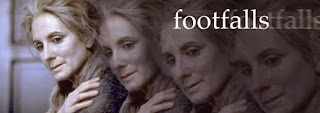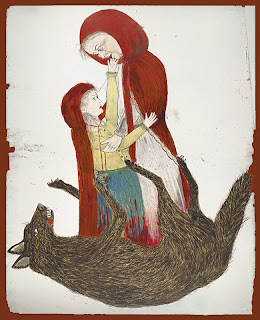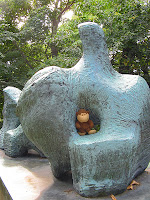To be perfectly honest, I didn't feel particulalry keen about going on the "Beckett Marathon" (that's my title, not the official one) which Alice obliged us to attend during the Festival. She didn't force me, but her enthusiasm made me feel I should accompany her - just in case, after all, I missed something good.
Nor do I especially want to write about it. But she insists we say at least something.
Samuel Beckett is a very bizarre writer: either a total crackpot or an inspired genius, depending on your viewpoint.
 |
| Samuel Beckett in Paris, 1985 |
he creates a mythical universe peopled by lonely creatures who struggle vainly to express the unexpressable. His characters exist in a terrible dreamlike vacuum, overcome by an overwhelming sense of bewilderment and grief, grotesquely attempting some form of communication, then crawling on, endlessly.
So you can see why I wasn't that keen.
He's best known for his play Waiting for Godot, which Alice first saw many years ago. So long ago, she can't even remember when or where. I suspect it was during her university years, maybe at a Student Drama Festival. But don't let's get her started again on her early acting experiences. . . She claims to have "enjoyed" it straight away. Oh, yes?
Alice decided to try the Beckett on Film events, partly because they were much cheaper than the live theatre ones. There were a total of nineteen plays! Some last up to two hours. Some however, are pretty short, from 35 seconds (Breath) to 20 minutes, so that three could be shown in one slot. Thank goodness, Alice only booked some of these sessions! We'd need our lunch, if nothing else.
The day before, we heard a talk by Michael Colgan, who, with Beckett's blessing, produced the films. This means he got together the money (which wasn't enough, of course) chose the directors and selected the actors he wanted. Not all the directors and actors of his first choice got on together, it transpired, but in the end the mighty project took off.
In the morning we first saw Catastrophe. It was quite amusing, actually, but with a hint of sadness at the end when John Gielgud turns out to be the one who is the butt of the manipulations, followed by triumph when he turns his gaze at the spectators - including us, of course. It was his last on-screen appearance, as he died a few weeks later.
 |
| Damien Hirst on the set of "Breath" |
I reckon it's Beckett's ultimate summary of life (but not mine): you're born, it's all a load of old garbage, and then you die.
One of Alice's favourite Beckett quotes is, They give birth astride of a grave. Yes, but we do have some fun as well, don't we? Even the writer himself adds, the light gleams an instant, before he finishes with, then it's night once more. Here's to the gleaming!
After a short break came Happy Days: that one with the woman buried up to her waist in the first act, and up to her neck in the second. She tries hard to pass the time (a common Beckett theme) and seem cheerful, but even so, feels the need of an event sometimes.
Alice actually likes the play but not this rendition. She thought it could have pointed up the different imaginary listeners to whom Winnie speaks, and take more account of her underlying desperation. There have been other interpretations, of course. The best bits for me were when she took various objects from her big black bag to inspire herself: a toothbrush, or a gun.
At five in the afternoon we went to the Lyceum for our one live Beckett event Eh, Joe. An old man is checking his grimy little room to make sure no-one's there, but when he tries to sleep, he hears a woman's voice, taunting him with his past despicable behaviour. He does respond, but says nothing at all.
Originally written for TV, one would then have seen his reactions in ever closer close-up. On the stage, Michael Gambon's craggy face was projected onto a guaze: huge beside the apparently "tiny" figure on the bed. See the picture in The Independent.
The Guardian thought it was worth four stars; the Telegraph admired it as well. Alice and I were more iffy. Perhaps he was getting stale, or saving himself for the evening performance; but we thought his repertoire of expressions was disappointingly limited. Sorry folks, if you're a devoted fan.
It's Joe, no: Dumbledore, yes.
[Click on the images, won't you?]
 Immediately after that, it was back for the rest of the films. We were certainly getting a bit tired by then, and there was no time for our afternoon cup of tea! We're getting a bit tired now as well, writing this up, so forgive us if we're a bit more succinct, and just follow the links for extra info.
Immediately after that, it was back for the rest of the films. We were certainly getting a bit tired by then, and there was no time for our afternoon cup of tea! We're getting a bit tired now as well, writing this up, so forgive us if we're a bit more succinct, and just follow the links for extra info.Go on, Alice, you can be succinct if you really try hard enough, can't you?
 |
| Ohio Impromptu |
 Then it was on yet again,
Then it was on yet again,with What Where (a political work about power, torture and guilt, slightly sci-fi in setting) plus Footfalls (a spooky atmospheric piece - about the legacy of generations perhaps?) and Come and Go (a three minute repetitive, geometric and emotional dance between three old women, about secrets, belonging and outcasts) in another block of short films.
And guess what the grand finale was? That original shocker, Waiting for Godot, no longer quite so disturbing to contemporary audiences. Despite the much parodied central idea of waiting for a mysterious individual who'll set the world to rights but never actually arrives, and the cruelty of some incidents, it's actually a very funny and poignant play, full of wry humour, and compassion for humanity.
Maybe Beckett's lovely aphorism, Ever tried. Ever failed. No matter. Try Again. Fail again. Fail better. sums up the spirit of this classic drama. I grew to feel very fond of poor old Vladimir and Estragon, and even mellowed in my appreciation of Samuel Beckett. So, thank you Alice, it was a good marathon to have run.










.jpg)















